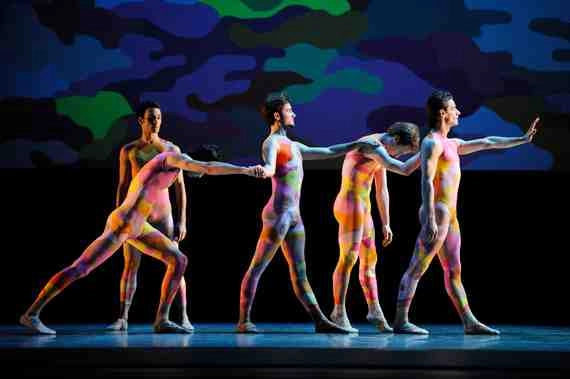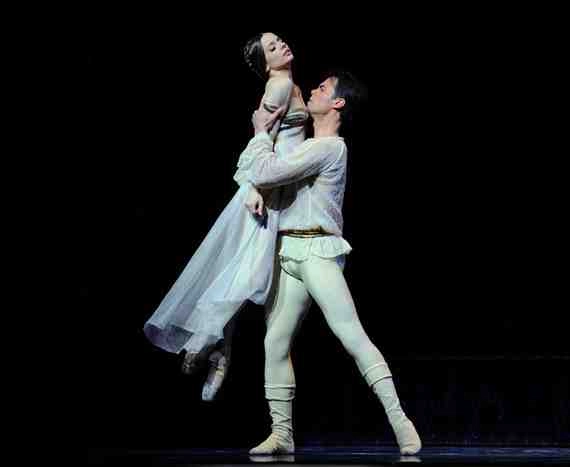Dance
San Francisco Ballet: It’s in the Programming
For most dance companies, presenting one new three-ballet program in a week is challenge enough. In the course of its seasons, however, San Francisco Ballet often presents two complete line-ups within the same time frame. That is, six complete ballets in one week, often including world and company premieres.
This past week, the company offered its Programs 2 and 3 — both were all-contemporary outings, and each contained a world premiere. All were performed to the highest standard and incorporated stellar production values. But one program worked better than the other.
Program 2: Chroma, Beaux, Number Nine
The world premiere of Mark Morris’s Beaux, set to Martinu’s Concerto for Harpsichord (1935), is a gentle work created for the company men. In contrast to the usual bravura leaps and beats normally used to showcase talented male dancers, Beaux explores different territory. In a Peter-Pan-and-the-Lost-Boys manner, Morris has the men create a visual picture of the hidden, light-hearted youth inside, and the sunny, patterned costumes and backdrop by designer Isaac Mizrahi underpin Morris’s intent. The dancers were equally matched, equally wonderful.
It’s a daring work. These are not boys dancing; they are men, and it is, at first, uncomfortable to see adults engaging in a version of high jinks most often practiced by adolescents on suburban front lawns. Not-quite-by-accident bumping into one another, silly acrobatics, and an oft-repeated airplane maneuver reinforce an innocence maybe lost, maybe buried, within most of us. It’s a ballet that can grow on an audience over time as the territory it explores becomes more familiar.
Unfortunately, this is where the programming went wonky. Beaux, as is typical with world or company premieres, was placed as the centerpiece between two other works that are, effectively, “closers.” Meaning that they, either by virtue of aesthetics or exuberant attitude, are better suited to sending the folks out the door humming the choreography.
Beaux’s lead-in is Wayne McGregor’s Chroma — one of the stand-outs from last season — a minimalist exercise in risk management set to music by Jody Talbot and Jack White III (of White Stripes fame). Powerful, driving, the dancers are pushed to physical extremes, with choreography featuring hectic hand and arm movements, impressive (if overused) hyperextensions, and a riveting intensity by all involved. Dana Genshaft and Anthony Spaulding, in particular, captured the speed and timing with an attractive confidence beyond the technical requirements.
But, where do you go from here? Usually out the auditorium door, the audience buzzing with excitement, maybe even disagreeing on the work’s merits. It is not a piece designed for “let’s get a cocktail, maybe talk about where we are going after,” only to return to the theater for a soft, gentle program shift.
The program closed with Christopher Wheeldon’s Number Nine (also a last-season hit). Holly Hynes’ cheerful, yellow corps costumes set the basic mood for the ballet. This time, however, Mary Louise Geiger’s lighting design seemed darker throughout; it is not a felicitous change. The amazing SF Ballet corps performed the intricate footwork and nailed the tricky exits and entrances with a skill not found in many companies and, along with the four principal couples, captured the fun and buoyancy, completely on target with the music — Michael Torke’s Ash.
Program 3: Trio, Francesca da Rimini, Le Carnaval des Animaux
Fair warning: If your taste runs to the too-cool-for-school, studiedly understated, and pseudo sophisticated, the world premiere of Resident Choreographer Yuri Possokhov’s Francesca da Rimini, set to Tchaikovsky’s symphonic poem, might not be to your liking. For the rest of us, though, Wow!
In the best Bolshoi Spring-Waters-meets-Spartacus tradition, Possokhov embraces the tragedy and passion in a no-holds-barred, emotionally wrenching ballet centered around the tale of the two adulterous lovers, her cuckolded, murderous husband, and their inevitable demise and descent into the second level of Dante’s Inferno.
No physical risk is too great, no emotion too intense.
The story unfolds against the dark, imposing Alexander V. Nichols set, overseen by the grand entrance to the Inferno. Christopher Dennis’s lighting design, while dark, is not murky, allowing for the action to be seen clearly, without losing any dramatic impact. From the moment the Guardians (a commanding Jeremy Rucker, Quinn Wharton, and Luke Willis) emerge from the hellmouth, we know that this is not going to end well.
The lovers, Francesca (Maria Kochetkova) and Paolo (Joan Boada), inspired by the story of Lancelot and Guinevere, surrender to their desires and set in motion the inevitable bad end to their tale. Unlike King Arthur, Francesca’s husband Giovanni (a menacing Taras Domitro) is not the forgiving sort; there is no withdrawing to a convent for Francesca. When Giovanni discovers the lovers, he kills them.
At its core, the ballet is an extended pas de deux — a tour de force of passion and longing. Kochetkova and Boada’s abandonment to the drama makes it easy to lose sight of their considerable technical prowess and strength. There is a frenzied desperation to their love, highlighted by stunning lifts, catches, and spins. Once Giovanni discovers the pair, the action becomes even more intense and furious, culminating in a startling, throwaway moment, where Domitro tosses Kochetkova blindly over his head and into Boada’s waiting arms. He then kills them both, only to have the Guardians draw him into the Inferno.
Throughout, the Greek chorus of ladies-in-waiting pose their disapproval in red Renaissance-inspired Sandra Woodall dresses, while the Guardians await the chance to introduce the characters to their new home below.
As a perfect foil to the drama, the evening closed with the return of Alexei Ratmansky’s gently comic Le Carnaval des Animaux, set to the familiar Saint-Saens score. To paraphrase an old L.A. punk tune, “We’re gonna have an animal party tonight, all right!” This one is just plain fun.
From Courtney Elizabeth’s charmingly inebriated Elephant to the humorous Hens of Elizabeth Miner, Dores Andre, and Clara Blanco, this is a delightful look at human foibles through a barnyard looking glass. And was there ever a Jellyfish more jelly than Sofiane Sylve, whose poignant follow-up Dying Swan transcended the comedy.
To bookend the program, Helgi Tomasson’s Trio, acted as the perfect, nuanced lead-in to the Possokhov drama. Set to Tchaikovsky’s Souvenir de Florence, the ballet is a series of three unrelated vignettes depicting remembered moments, both joyous and sad.
In the first, Vanessa Zahorian, revealed a charming radiance and luminosity that she generously shared with her partner, Vitor Luiz, and the audience. In the second, a yielding Sarah Van Patten, skillfully partnered by Tiit Helimets and Vito Mazzeo, embraced the more somber struggle between love and death. The third and fourth movements are more of a remembered journey to foreign lands, complete with Russian folk-inspired music and steps. Frances Chung and Gennadi Nedvigin led the spirited and spot-on corps in a reaffirmation of life’s more positive moments.
From beginning to end, this programming arc worked, leading the audience beautifully, gently, into the intensity of the central ballet, then even more carefully out. Perfect.
The Music
When reviewing dance or theater performances, the tendency is to mention the music and musicians as a postscript: The orchestra, conducted by XXX, played admirably throughout. (I admit that I am guilty of this more times than not.) The San Francisco Ballet orchestra and soloists deserve better.
This past week, the orchestra, led by Martin West and Guest Conductor Charles Barker, tackled six works ranging from Tchaikovsky’s lush romantic material to rock- and Latin-infused rhythms, with stops in between for neoclassic and impressionist pieces. That’s a lot of music for one week. They were terrific!
Special mention also needs to be made of the fine solo instrumental performances: First, Bradley Moore, whose deft harpsichord underlined and lifted the dancers in Beaux; and, in Le Carnaval des Animaux, where soloists Eric Sung (cello) Natal’ya Feygina (piano) lightly emphasized the humor inherent in the work onstage. And then there is pianist Michael McGraw (Le Carnaval des Animaux and always) — San Francisco Ballet’s secret musical weapon. Never a missed comedic, dramatic, or musical moment.
Program 2: Chroma, Beaux, Number Nine and
Program 3: Trio, Francesca da Rimini, Le Carnaval des Animaux
In repertory through February 26, 2012
San Francisco War Memorial Opera House
www.SFBallet.org
Former dancer, Geri Jeter, has been editing and writing for over fifteen years, writing on dance, food, music, NASCAR, technical theater, and Italian-American culture. For the past five years, she was the dance critic for the Las Vegas Weekly; in 2007 Nevada Ballet Theatre presented her with the Above and Beyond award. Now living in San Francisco, Geri is excited about covering the entire scope of West Coast dance. You can read more of her dance writing at her blog Dance Blitz (www.dance-blitz.com) and follow her Las Vegas and San Francisco restaurant reviews at DishKebab (www.dishkebab.com).








1 Comment
You must be logged in to post a comment Login